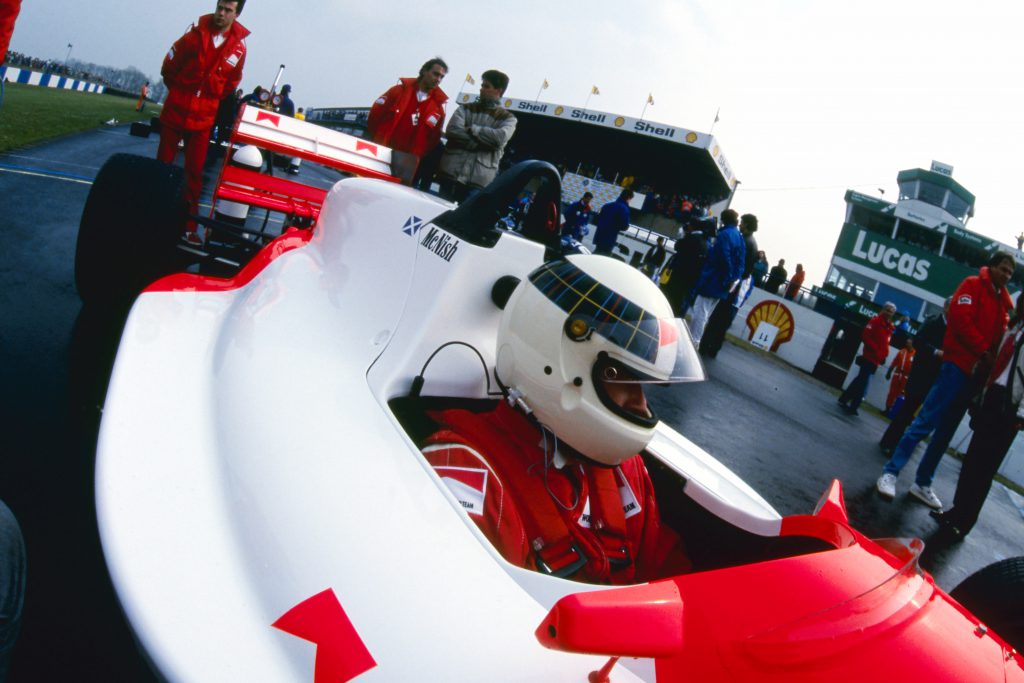Up Next

In the latest of our series of highlights from The Race’s first year, here’s another chance to read Allan McNish’s recollections of the tragic Formula 3000 crash at Donington Park that shaped the rest of his life – first published on the 30th anniversary of the accident back in April.
Both Glenn Freeman and Matt Beer selected this as one of the most important and profound articles we’ve run in 2020, and its writer Sam Smith put it at the top of his list from our first season too.
“I absolutely love to try to tell stories that have not been properly written before and The Race has allowed me to do a bit of that this year, which is great,” said Sam.
“From the bonkers niche of the wonderfully nutty ‘racing alien cult’ character Rael, to the emotional rollercoaster of Roberto Moreno’s day of all days at Suzuka in 1990, I’ve loved telling those stories with detailed background and research.
“However, my two-hour conversation with Allan McNish on his formative and dreadful experience as a 20-year-old Formula 3000 rookie at Donington Park in 1990 stands out most from this year.
“His recollections were often tough to listen to, let alone what they must have been like to recall, but for me his story added another layer of admiration to someone I’ve had a massive amount of respect and affection for over the last 30-plus years.”
In motorsport just a few seconds can change so much.
When Allan McNish powered his DAMS Lola T90/50 Formula 3000 car out of Coppice Corner and got a run on rival Emanuele Naspetti at Donington Park one grey Sunday afternoon in April 1990 – 30 years ago today – a great deal altered.
A pivotal stage in the then-20-year-old’s life had begun, and a month of tragedy and triumph would carve an additional layer of granite into one of the UK’s most successful racing drivers of the 21st century.
“I don’t really remember very much as the car hit the wall hard and broke in half. Every memory is lost from there really, which is possibly a good thing” :: Allan McNish
McNish had already endured some tough lessons. At the end of 1989, he had been declared British F3 champion but the following March a courtroom decided that David Brabham was the actual title-winner by overturning penalties for engine irregularities on Brabham’s car.
By then McNish couldn’t stay in F3 so the step up to F3000 was inevitable, especially as he had already made his race debut in the senior category at Dijon in October of ‘89.
At this stage of his career you could say McNish was ahead of his former GM Euroseries team-mate Mika Hakkinen, who had endured a bruising season of F3 in 1989 with Dragon Motorsport and an unwieldy Reynard chassis.
It was then that a classic Marlboro young driver system domino effect played out. The one that fell for McNish was the French squad DAMS, which had snared the Marlboro contract from under the nose of Pacific Racing for the 1990 International F3000 season.
The Jean-Paul Driot led DAMS squad was, according to McNish, “basically king of the hill, they’d dominated the end of the 1989 season [with Erik Comas] and just become DAMS from GBDA. They were going to be the team to beat.”
The other ace up DAMS’ sleeve was that it was the Lola works team in all but name. Lola’s Mark Williams penned T90/50 was an all-new design and the early indications were that a rocketship had blasted straight out of the Huntingdon factory.
“I remember jumping from F3 into the F3000 car for the first time at a Silverstone test and it just felt so bloody quick,” McNish tells The Race.
“Aero-wise it had a lot more grip, it was just bigger, it was noisier, it was faster, it was just everything and it made you sort of feel like a tiny little boy stepping up into a man’s world – which to a great extent it was.”
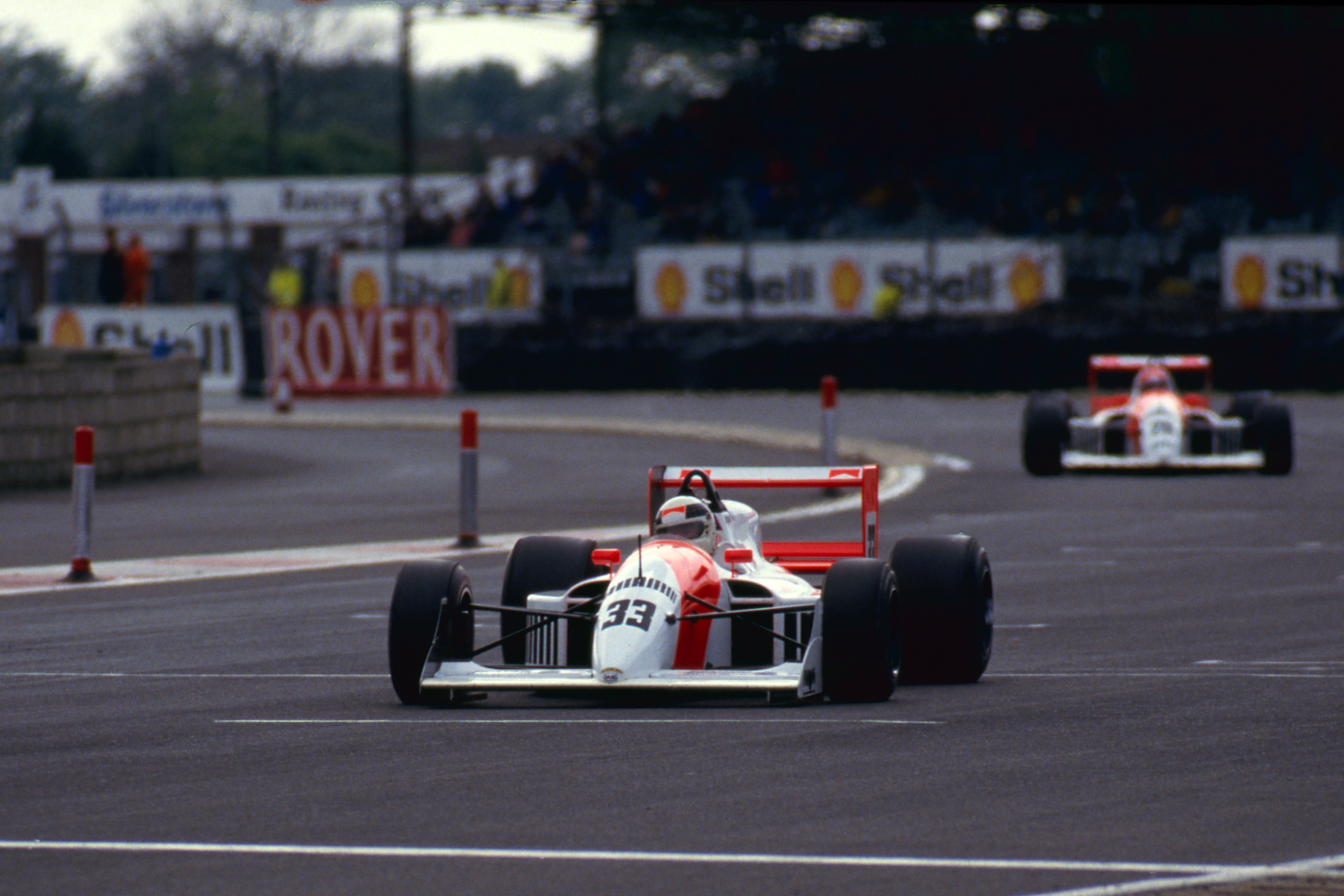
Testing had gone well for McNish, DAMS and Lola. But that year’s Reynard 90D designed by Malcolm Oastler had evolved from the title winning 89D and was also rapid. It would be a battle royal all season long between Reynard and Lola, and it began with a McNish-friendly home double-header of an opening round at Donington followed by Silverstone a month later.
Fifth place in Donington qualifying was a fine start for rookie McNish but drama struck pulling away from the dummy grid.
“I stalled it,” he recounts. “Then instead of taking my place at the back of the grid, I came into the pitlane to change tyres because it had been wet in the morning, and it was actually drying up reasonably quickly. It was a correct strategic decision.”
Fighting his way back through the pack impressively, McNish caught sight of the Eddie Jordan Racing Reynard of Naspetti, which was still on an increasingly inferior wet tyre, and struggling.
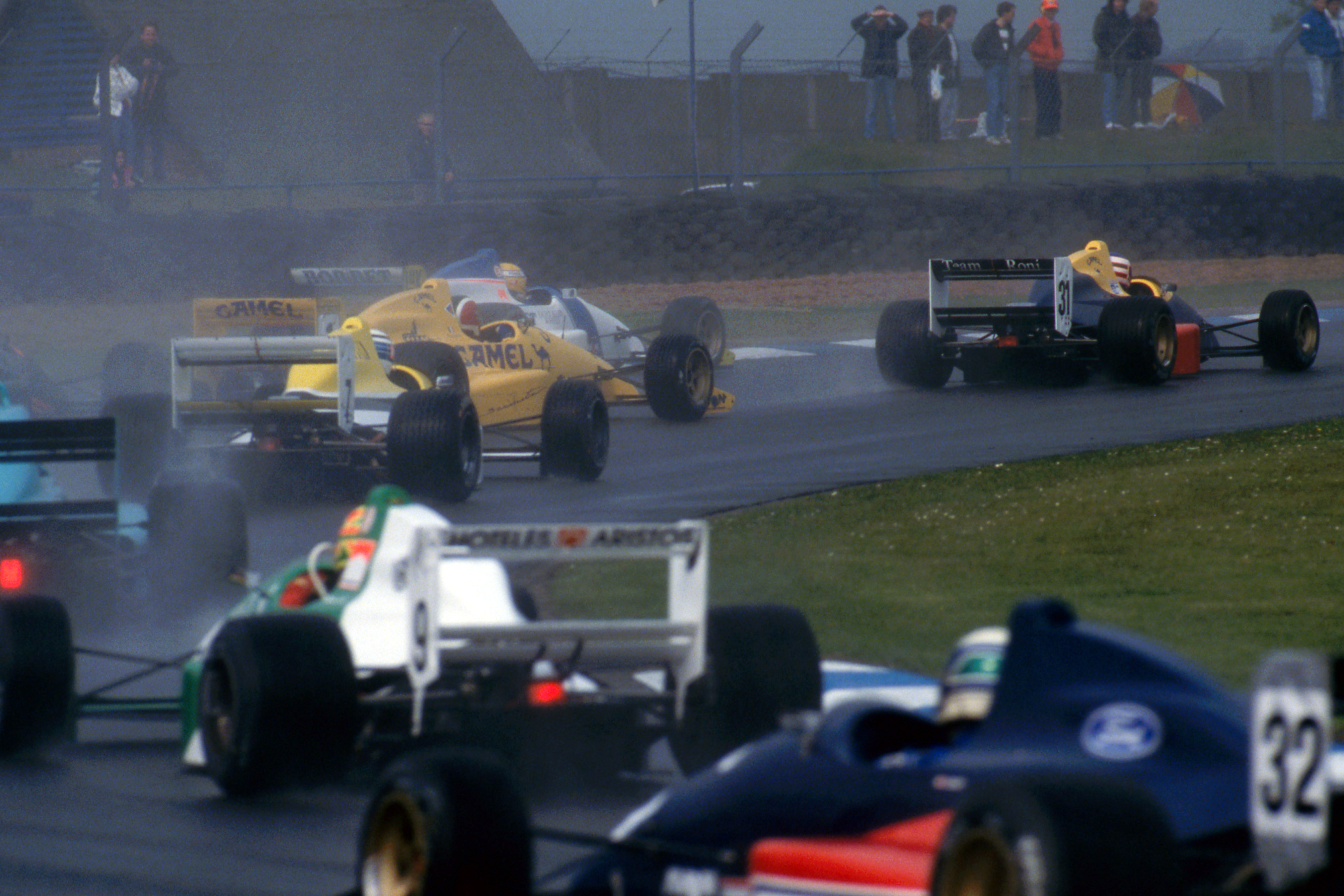
Exiting Coppice Corner McNish got a better run and pulled to the right just as they approached the bridge prior to the braking area for the Esses.
“I was trying to get alongside, purely to hold him on the inside, so that I could do a cutback coming out of the chicane, down to the hairpin,” recalls McNish.
Naspetti, though, didn’t see where McNish was in relation to him and cut across on his normal line.
There then came a terrifying moment when a point of inevitable contact was reached.
McNish was squeezed across to the grass and the wheels of the Reynard and the Lola became interlocked at around 160mph.
“I remember everything until I hit the wall,” McNish says.
“Then the car took off and at that point honestly I don’t really remember very much as it hit the wall hard and broke the car in half. Every memory is lost from there really, which is possibly a good thing.”
In an accident of dreadful violence, the tub was shorn of nearly all its components and cartwheeled over the wall, across a pathway and down into a pedestrian tunnel that linked to the exit of the circuit between the Donington museum and the Esses.
The engine and gearbox flailed dreadfully through the air, scattering spectators and marshals.
Remarkably the race was not stopped and only double waved yellow flags were displayed at the scene.
“You think you’re invincible, you think everything’s all fine and then suddenly it all changes” :: Allan McNish
A shocked McNish was helped from the wreckage and then surreally watched the race from a marshal’s post for several laps with fellow retirees Giovanna Amati and Andrew Gilbert-Scott. He has no memory of this.
“I remember only a couple of things over the next three or four hours,” he says.
“I recall seeing the tunnel and being in the car still, not really knowing much about it and then the next thing I remember is being in the medical centre and then in the hospital itself.”
He was largely unaware of a tragedy occurring at the scene of the accident.
One of the spectators hit by debris had been Ray Plummer, who was a mechanic for Bradley Joyce who was competing in the supporting Renault 5 Turbo race. Tragically Ray did not survive his injuries, despite heroic attempts by fellow spectators and paramedics at the scene.
“I’ve got a sort of vague memory when I was in the medical centre that some people had been injured,” says McNish.
“But it was actually at the hospital, when the police came, that the full impact of it hit home. Because they obviously had to take statements as there had been a tragedy. It was quite plainly very difficult to come to terms with.”
McNish was discharged from hospital the following morning but still concussed. A support system quickly grew around him.
Jackie Stewart, who had been at the race as part of the Paul Stewart Racing team that was running John Jones and Marco Apicella, was part of it.
“Jackie has always been there for us,” says McNish.
“When I say ‘us’, I mean my generation of Scottish drivers, to make sure we were taken care of with the best medical services possible. That meant going to see [F1 doctor] Sid [Watkins], so that is what he organised.
“Ron Dennis too was very good, because I was also affiliated to McLaren at that time [as test driver], and he was very supportive.”
McNish went to see Watkins at Coldstream in Scotland and was checked over on the Monday afternoon after the shunt.
“Sid said ‘you’ll be OK, you’ve got quite bad concussion, though’ and then I was sent to London for further tests and checks.”
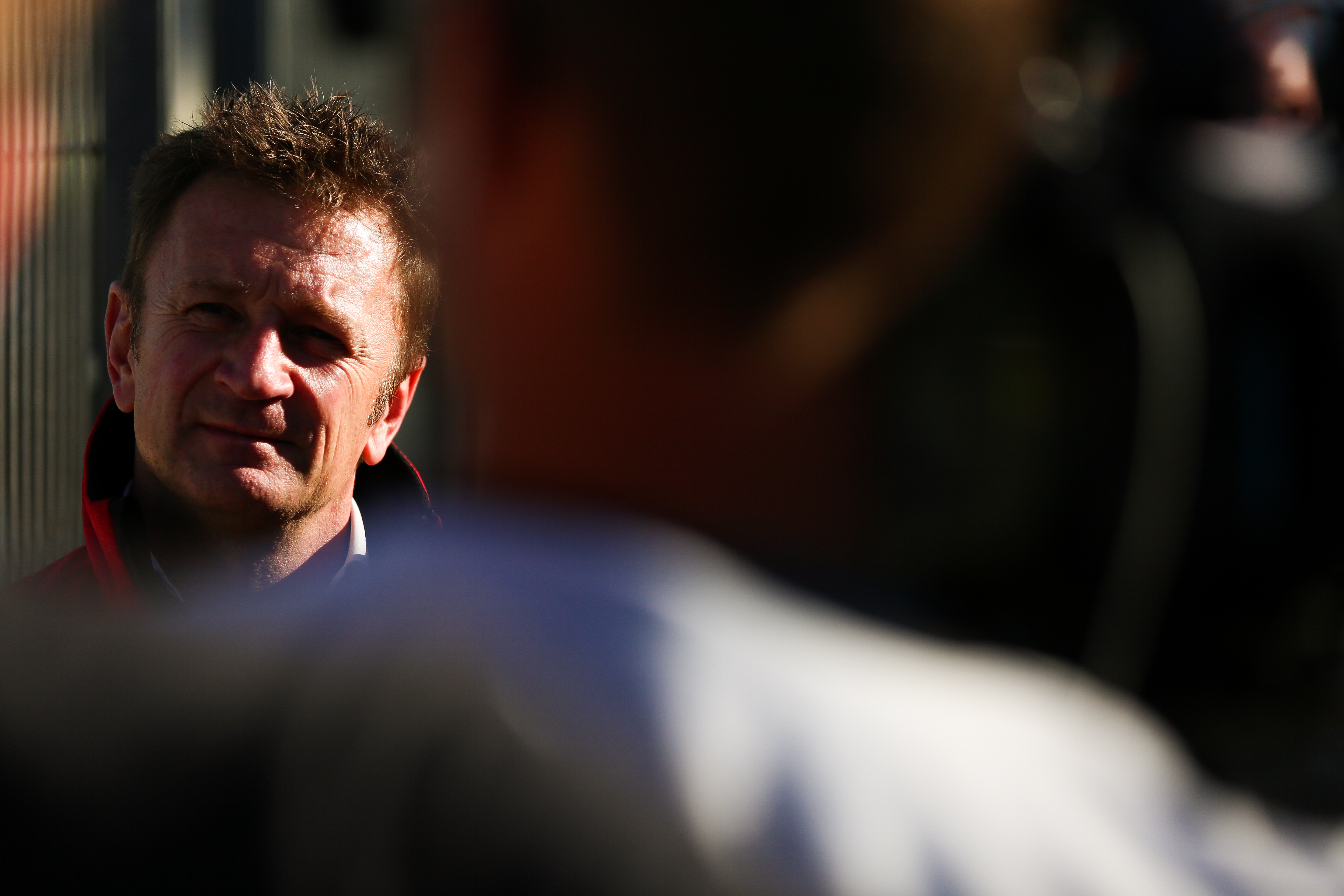
While McNish recovered from his concussion there was the much deeper trauma of Plummer’s death to try to come to terms with.
Post-traumatic stress disorder is a well understood condition now, but in 1990 its clarity and clinical diagnosis was less clear, especially when it came to attempting treatment.
McNish had gone through an experience that would inhabit him to some extent for the remainder of his career and life.
“It was without a shadow of a doubt the toughest thing that’s ever happened in my life,” he says.
“You think you’re invincible, you think everything’s all fine and then suddenly it all changes.
“And it’s the dynamic of a split second that changes not just your life but also other people’s and that hits home very strongly.
“This is an area where honestly I don’t think many people realise how it can affect you and that’s the area where I think racing drivers, sportspeople, people in everyday life have a similar life-changing situation.”
Trying to process the situation was certainly not the work of a moment for McNish, especially at a time when in his own words “there was no support, no way of dealing with it apart from just sort of getting on with it”.
McNish went to Ray Plummer’s funeral with his father after they had asked for permission from the Plummer family.
“I can tell you, that was a tough day, but I had to go,” he says.
“We paid our respects, spoke to the gentleman’s wife. That was a very tough point because he had family and they were grieving for something that I was part of.
“I asked if it was possible to go and they said yes, and were supportive. It must have been so tough for them, they were incredibly strong people.”
McNish was still suffering blurred vision and headaches in the days and weeks after the accident.
“I wasn’t really sure where this was all going, as I’d never had a concussion like that before and I was unsure if I could drive at Silverstone from a physical standpoint,” he says.
Practically, the DAMS team was readying a new Lola T90/50 for McNish, should he be cleared to race.
Team boss Driot had found himself in the difficult position of trying to celebrate his other driver Comas’s win at Donington, while McNish was in the medical centre.
“I didn’t always agree and see eye-to-eye with Jean-Paul, but in that whole situation he was quite clear and supportive that the car would be there when I wanted to get back in it,” McNish remembers.
“The engineer Alain [Rouy] and my number one mechanic, Pascal [Houtin], were also there, ready and waiting to go when I was able to.”
“The second I sat in the car and drove out of the pitlane it was completely natural, and that was a huge, huge relief” :: Allan McNish
McNish travelled to London with his DAMS engineer, Paul Crosby, to see Watkins again on the Monday prior to the next round at Silverstone.
“This was the determining factor if I could drive or not,” remembers McNish.
“It was quite a rudimentary sort of test at the time, where they wired electrodes up to your skull, checked your brain electricity, and then flash a strobed light into your face for about 20 minutes.”
He was cleared to race from a physical standpoint, yet the mental battle would continue.
McNish and Crosby travelled direct from the medical tests in London to the Croix-en-Ternois track in northern France and met up with the team to conduct a brief shakedown of the new Lola.
The sinuous Croix track was a far cry from the flat-out sweeps of Silverstone, though, and the team was apprehensive about how McNish would tackle his first time back in a cockpit since the accident.
“The second I sat in the car and drove out of the pitlane it was completely natural, and that was a huge, huge relief,” he says.
“I did about 40 laps and I felt good, I could feel the car, the brakes, the leaning on the edge of the tyre and it was a lot more connected than I ever would have expected it to be.”
DAMS then travelled straight from France to Silverstone for what was one of the biggest meetings of the year in the UK, as it encompassed the Empire Trophy for the World Sportscar Championship and the International Trophy for F3000.
Qualifying went well for McNish at a track where Lola’s superiority was clearly evident and he took a sensational pole with team-mate Comas alongside him on the front row.
McNish lost impetus at the start and fellow Lola runner Damon Hill took his Middlebridge T90/50 into a lead that he held for 16 laps until an electrical issue allowed McNish through.
He held that lead over team-mate Comas all the way to the chequered flag and a famous victory.

“I was generally very good on high-speed circuits and high-speed corners,” remembers McNish.
“I would say, throughout my career, I was able to measure up the high-speed tracks pretty well and the old Silverstone was certainly that.”
Authentic modesty has always been an intrinsic part of McNish’s make-up and in describing his victory there is still, 30 years on, little hint of acknowledging heroics in his drive.
“I remember doing an interview before going into the press conference,” he says.
“There was this talk straightaway about Donington and that did drag me back there, no question.
“But to be honest I think it was all still sitting there and it was still all very raw.
“I think the thing it [the win] did for me, was it proved I still had the capability and the talent.
“It was sort of a mind over matter thing that I still had the capability, but the actual emotional, mental side of the incident, I don’t think it had any effect in all honesty with you at the time. That was a much longer process.”
Whichever way it was viewed there was no denying that McNish had completed a remarkable journey in the space of 27 confusing, emotional and perhaps defining days.
“You can’t handle it entirely. It’s 30 years ago now and I still think about it. I don’t think I’ll ever get fully over it” :: Allan McNish
Twenty one years on from that tumultuous spring, McNish had a not dissimilar accident at Le Mans, when his Audi LMP1 car clipped Anthony Beltoise’s Ferrari and deflected off a barrier, scattering photographers and marshals. Did that trigger a flashback scenario?
“No question about that, no question,” he replies.
“There are some things you can control, there are some things you can’t and in that respect I was so much more aware of that side of things [in 2011].”
It was also a determining factor in McNish refusing to get strapped into the cockpit of his Audi at a Sebring test the year after the Le Mans accident.
Barriers were taken down at Turn 3 as circuit officials prepared for an IndyCar test two or three days later and McNish’s stance was clear.
“There were people cleaning up there and I refused to drive, because I will not consider going out and putting other people into a situation that I know is high risk,” he recalls.
Audi team boss Dr Wolfgang Ullrich backed up his driver and personally refused to let the car onto the track until the barrier situation was rectified.
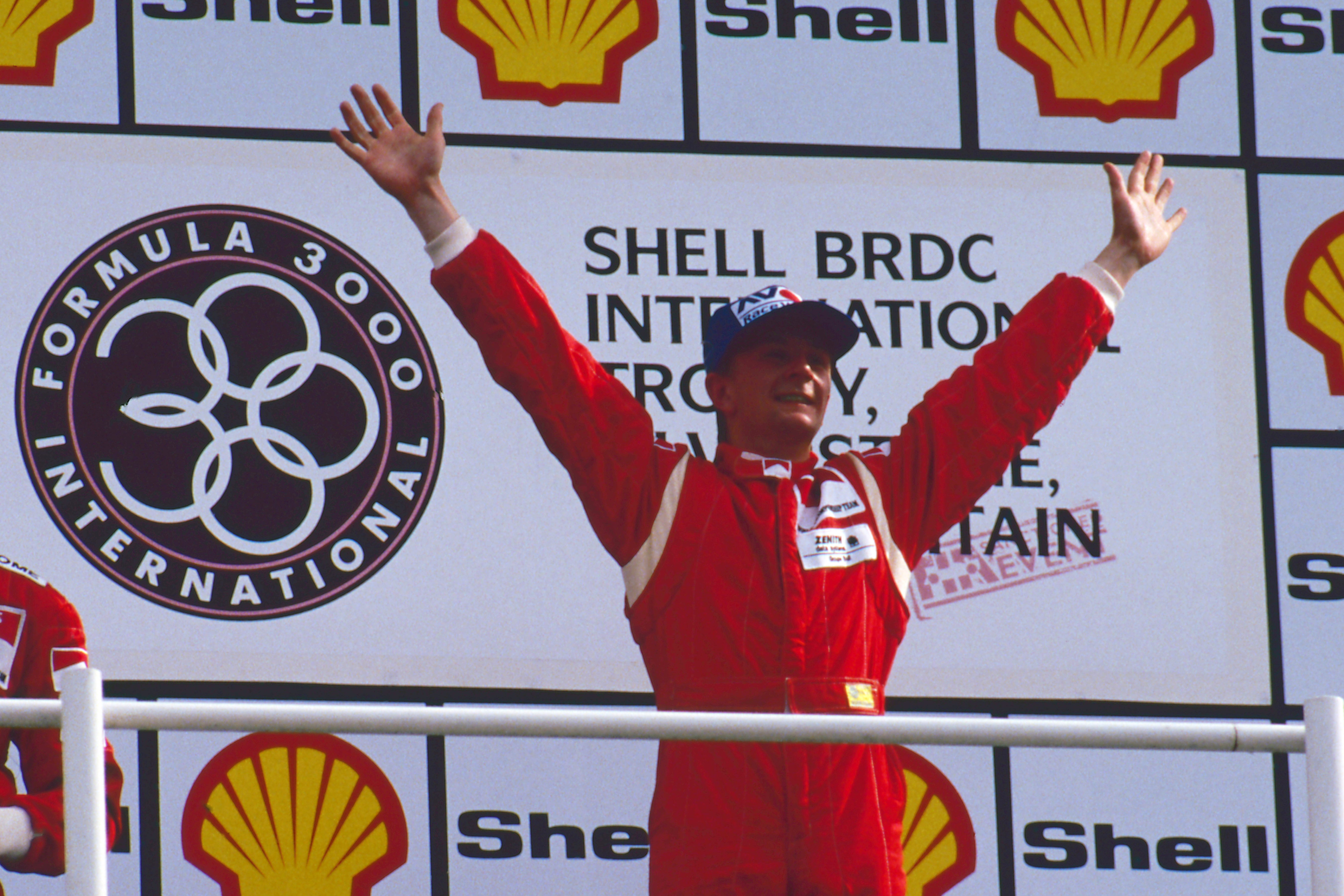
The mists of time can both mask and evoke memories. Particularly those that McNish experienced so viscerally three decades ago now.
“I’m sure there is an element now of looking back, and understanding that there were occasions where it had an effect on me, my personality or my driving because it was such a big event,” he says.
“You just don’t go through these without having some sort of residue from it mentally, especially when you don’t necessarily have the tools to deal with it at a young age.
“You can’t handle it entirely. It’s 30 years ago now and I still think about it.
“I don’t think I’ll ever get fully over it. You come to terms with it, you understand how the process happens over time but it kind of still sits there.”
Thanks to Bothwell/JEP archive for assistance with pictures


